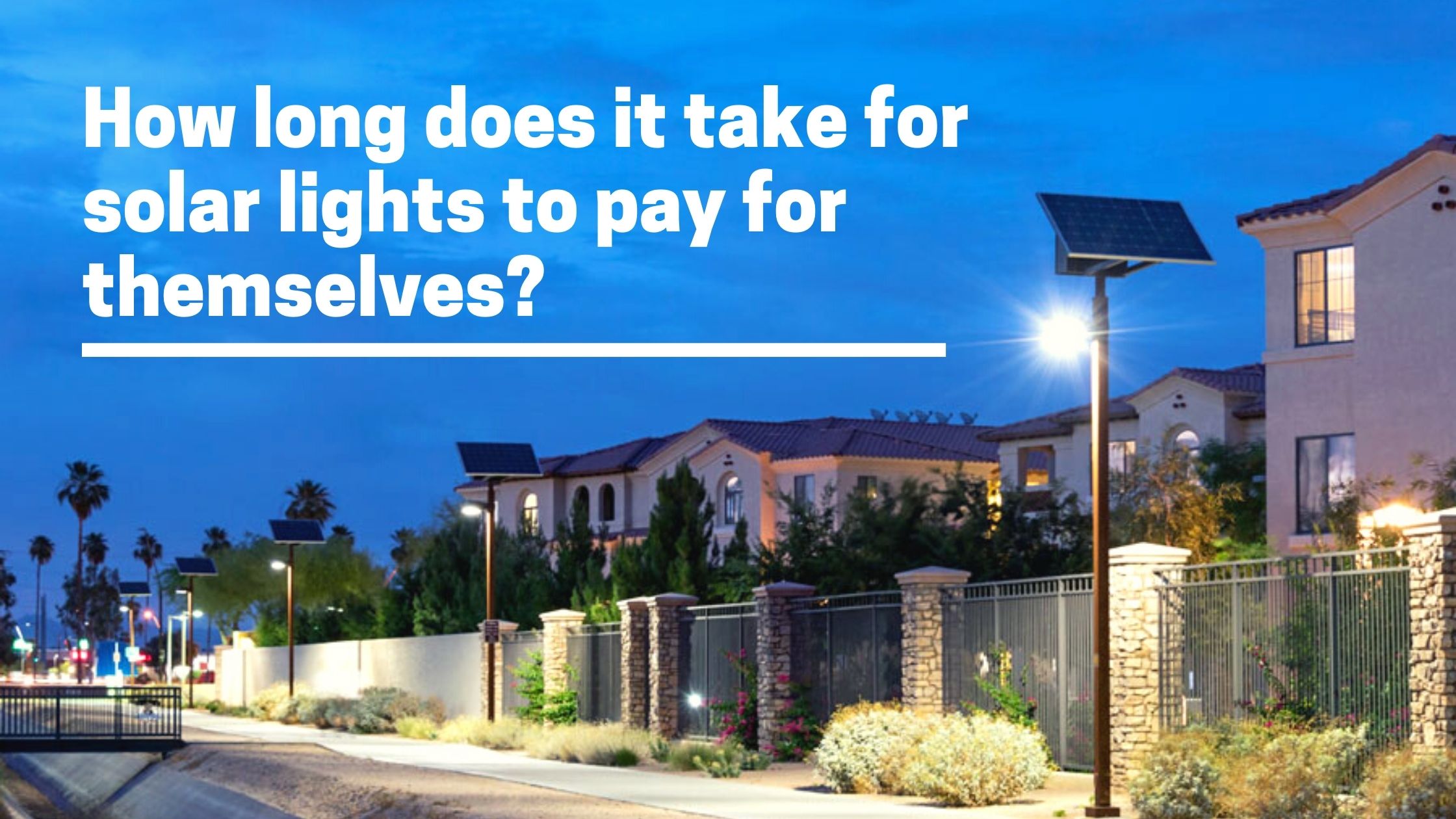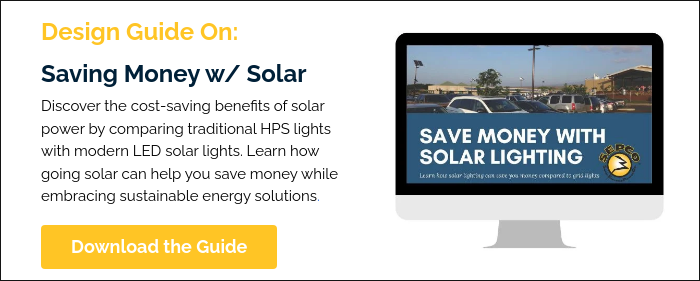How long does it take for solar lights to pay for themselves

Contents
According to the EIA, over 219 billion kWh of electricity is used for lighting every year. Assuming 14 cents per kWh, this is the equivalent of 30.66 billion dollars a year. Further recent studies showed that lights are responsible for 8% of the global carbon emissions, which is around 201.48 billion pounds each year.
Luckily, there is a very cost-efficient way to reduce our impact on the environment and save billions of dollars each month; replacing our electrical lights with off-grid solar lights. The solar lighting industry has dramatically evolved over the past few years. We have many solar lighting applications, from small accent lights to the high-powered street and parking lot lights that can provide over 10,000 lumens.
But how much money can a solar light save me?
Well, the short answer is a few cents per day on the utility power, from 2.5 to 40 cents per day depending on your solar light wattage, how long it runs each day, and what your local utility costs are. However, it is more complicated than that. You should consider a few factors when looking at the payback period of a solar lighting system.
However, if you are looking for a more detailed answer, this article is specially made.
In this article, we will go through:
- How to calculate your electrical light energy consumption
- How much money can a solar lighting system save you
- How long does it take for solar lights to pay for themselves
How to calculate your light energy consumption?
Energy consumption is measured in kWh, which is how many kilowatts does your system drain from the grid for every working hour. Calculating your lights’ daily power consumption is very easy. All you need to do is multiply your light’s operating wattage by how many hours it works per day. For instance, let's assume we have a 100-watt street light that works from dusk to dawn (12 hours), then the daily power consumption would be 100*12 = 1200 watts.hour = 1.2 kWh per day.
This calculation is simply how much energy is being used. The way a power company charges varies from company to company and location to location. Other fees may be included, such as fuel charges, maintenance fees, rentals, etc.
Unlike grid lights, solar LED lighting systems to produce their own power and take nothing from the grid. There is almost no maintenance with these systems. The only thing that will need changing over the 25-30 year life is the batteries, which is once every 5 years or so depending on how the system is sized and the depth of discharge of the batteries over the course of the year.
How much money can a solar light save you?
-
Electricity Saving
In the previous example, our imaginary 100-watt street light consumed around 36,48 kWh per month. On average, the grid charges you approximately 14 cents per kWh, which means that a single electrical 100W street light will cost you $5.10 per month and $61.28 per year in just the energy costs, additional fees still may apply.
On the other hand, if you opted for a 100-watt solar street light, you can save over $61 per year and eliminate all the additional fees since you own your light. That's not all to it; solar lights also protect you from the rising electricity costs.
According to the Energy Information Administration, the average yearly increase in electricity cost is 1.5%. So keeping that in mind, the annual savings are higher than $61. It actually gets cheaper for you to own your light year after year.
-
Maintenance Cost
In maintenance terms, solar lights require very little to no maintenance at all. The only thing that needs to be completed is the battery change every five years or so. The solar panel acts like a photocell working with the control electronics. And since there are no moving parts, there really isn’t much to break down.
If your solar light does break down, repairs are rather simple. There are guides online to help with smaller solar lights stopped working, and most manufacturers of large-scale systems are available to help a technician do some field troubleshooting to figure out the problem. Typically the problem is either shading, a wire not installed properly, or blown a fuse. Since all systems are either 12 or 24 Volts DC, no special equipment other than a DC voltmeter is needed for the troubleshooting.
Standard electrical lights rely on cheap photosensors to turn on and off the lights. These photosensors constantly break, leaving the lights turned on 24/7, costing you more energy costs, or requiring constant upgrades.
Electrical lights are connected to the high power grid. If there is a break in the electrical lines, then you most likely need to call an experienced electrician to deal with it, which can cost you around $200 or more per hour, plus repair costs. Depending on where the problem lies, the costs can go up exponentially with repairs.
-
Installation Cost
Since the upfront costs of solar lighting systems can be high, especially one commercially designed for a specific project, just trying to find a breakeven point by calculating energy cost savings is not the best first step when it comes to thinking about costs. The entire project needs to be looked at in a bird’s eye fashion and see where every dollar is spent.
What are the costs associated with bringing in grid power to a specific location? Overhead power can run between $5 and $10 per linear foot plus an additional $500-3K per pole to get the power to the correct location, according to Angi. Underground runs are about $20 to $40 per linear foot plus an additional $1000 for the transformers. Once this happens, the electric meter box needs to be installed at a rate of around $100 to $650 each.
The rest is pretty similar between grid and solar. The pole footers need to be designed and poured. Light poles need to be installed. The wire needs to be run from one pole to the next on a traditional grid setup only. Solar lighting systems have all the wiring located at the top of the pole, no need for pole to pole wiring.
How long does it take for solar lights to pay for themselves?
This depends on a lot of factors covered above, but let’s take two examples and put them side by side:
A complete turnkey system for a solar lighting project, say a SolarViper, would be around $5500, higher or lower depending on the location of the installation, operation requirements, and many other factors. Still, a good mid-range would be around here.
A complete light fixture and pole for an AC project would be around $1500, give or take on options, addons such as arms, etc.
Installation costs for each would be around $750 to create the foundation and set the pole, so not much difference there.
This is where things start to vary greatly. That’s all the installation that is required for the solar light; however, the electrical light needs to include the cost of bringing the electricity to the pole. This can cost anywhere from $2000-$10000, higher in some cases, but let’s go with an average of $3500 for overhead and $6000 for underground wiring.
I’m sure now you can see where the two systems completely differ from one another. The costs, in the end, are very similar, so the electrical usage costs are like icing on the cake since now your solar light will cost you nothing for the next five years while you will still get a monthly bill for your grid light.
One last thing I want you to consider is this. There are federal incentives to using solar, not including some state and local incentives that are available. These incentives can make the pot even sweeter in favor of solar since this cost can include the purchase of the equipment and the installation.
As you can see, there are cases where grid lighting makes more sense than solar lighting; however, remember to take into account all aspects from breaking ground to the full life of the light when trying to make financial sense of the setups. You may be surprised where you are leaving money on the table by opting for a traditional grid light over a solar-powered light.
About the Author: Kami Turky, founder and editor at Solarenergyhackers.com. When he is not having fun with his family and friends, Kami loves to spend his time writing about renewable energy, sustainability, and tips to reduce carbon dioxide.

